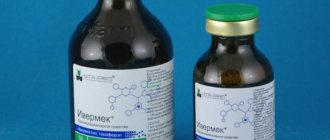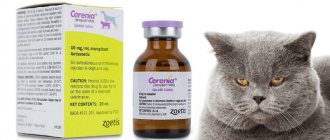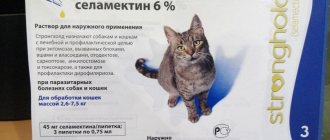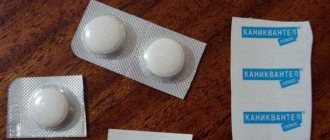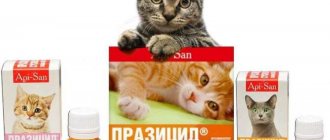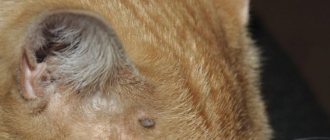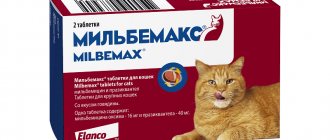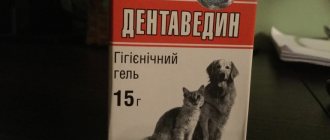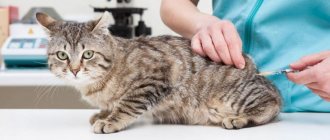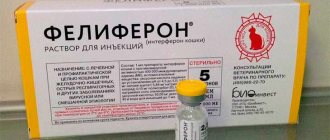Save the article:
There are diseases among our smaller brothers that require treatment with a potent human remedy. Of course, such drugs are not used in equivalent dosages, but in much smaller ones. Today it would be useful to learn about how ceftriaxone is used for cats, why and how best to do it.
Ceftriaxone dosage for cats
According to the instructions for use, the dose of ceftriaxone for cats is 25 mg/kg 2 times a day for 5-7 days, intravenously, intramuscularly.
Ceftriaxone 1.0 grams + 5 ml saline solution. 1 ml contains 200 mg of ceftriaxone, which should be used in cats weighing 8 kg.
Table 1 - Dosing of ceftriaxone for cats (1 g bottle + 5.0 ml of solvent) when prescribing the drug 2 times a day (dose 25 mg/kg body weight)
| Weight, kg | Dose, mg | Volume of the drug in ml |
| 0,5 | 12,5 | 0,063 |
| 1 | 25 | 0,125 |
| 2 | 50 | 0,25 |
| 3 | 75 | 0,375 |
| 4 | 100 | 0,5 |
| 5 | 125 | 0,625 |
| 6 | 150 | 0,75 |
| 7 | 175 | 0,875 |
| 8 | 200 | 1,0 |
Table 2 - Dose of ceftriaxone for cats (1 g bottle + 5.0 ml of solvent) when the drug is prescribed once a day (dose 50 mg/kg body weight)
| Weight, kg | Dose, mg | Volume of the drug in ml |
| 0,5 | 25 | 0,125 |
| 1 | 50 | 0,25 |
| 2 | 100 | 0,5 |
| 3 | 150 | 0,75 |
| 4 | 200 | 1 |
| 5 | 250 | 1,25 |
| 6 | 300 | 1,5 |
| 7 | 350 | 1,75 |
| 8 | 400 | 2,0 |
The main route of administration is intravenous and intramuscular. Many veterinarians use the drug subcutaneously. No adverse reactions were noted. Intramuscular injections are painful. With rapid intravenous administration - vomiting.
Composition and properties of the drug
The antibiotic Ceftriaxone is available in the form of a white or slightly yellowish fine-crystalline powder and contains the sterile sodium salt of ceftriaxone. The drug is packaged in 0.25; 0.5; 1 or 2 g in glass bottles, which are 1, 5 or 10 pieces packed in cardboard boxes with instructions.
Ceftriaxone is stored at room temperature not exceeding 25 0C, in a dry, dark place, away from children, feed and food. If all recommendations are followed, the shelf life of an unopened drug is 3 years from the date of manufacture. The diluted antibiotic must be put in the refrigerator. It cannot be stored for long periods of time and should be used no later than 24 hours later.
Pharmacokinetics
The pharmacokinetic properties of ceftriaxone, a third generation cephalosporin, were studied in five cats.
after a single intravenous, intramuscular and subcutaneous administration at a dose of 25 mg/kg. Ceftriaxone MICs have been determined for some Gram-positive and negative strains isolated from clinical cases.
The predictor of efficacy (t>MIC) was also calculated. Serum distribution of ceftriaxone was best fit in two-component and single-component open-label models with first-order elimination after intravenous and intramuscular and subcutaneous administration, respectively. After intravenous administration, distribution was rapid (t1/2d 0.14 ± 0.02 h) and moderate, as reflected in the volume of distribution (Vd (cc)) 0.57 ± 0.22 l/kg. In addition, elimination was rapid with plasma clearance of 0.37 ± 0.13 L/h•kg and t1/2 of 1.73 ± 0.23 h. Peak serum concentration (Cmax), tmax, and bioavailability for intramuscular administration were 54 .40 ± 12.92 μg/ml, 0.33 ± 0.07 h and 85.72 ± 14.74%, respectively; and for the subcutaneous route the same parameters were 42.35 ± 17.62 μg/ml, 1.27 ± 0.95 h and 118.28 ± 39.17%. The MIC of ceftriaxone for gram-negative bacteria ranged from 0.0039 to >8 μg/ml, and for gram-positive bacteria from 0.5 to 4 μg/ml t>MIC ranged from 83.31–91.66% (10–12 h) from the recommended dosing interval (12 h) for E. coli (MIC90 = 0.2 μg/ml).
Side effects and overdose
The drug ceftriaxone also has side effects. The body's reaction can be expressed in:
- disruption of the functioning of the digestive organs;
- flatulence;
- bronchospasm;
- impaired functioning of the kidneys and liver;
- allergies to medication.
A side effect may occur in a cat that is in poor health, as well as during the period after sterilization. Old cats and young kittens come under attack.
Warnings/Precautions
According to the instructions for use of ceftriaxone for cats, the presence of an allergy to penicillin or another beta-lactam antibiotic should alert the veterinary medicine physician
to carry out a skin prick test. Discontinue if sonographic signs or symptoms of urolithiasis or oliguria occur. Renal failure in cats: monitoring; reduce dose if drug accumulation occurs. Chronic liver disease or nutritional dystrophy (impaired synthesis or storage of Vitamin K): monitor prothrombin time. Both hepatic and significant renal impairment: usually maximum 50 mg/kg/day. Ensure adequate hydration.
Contraindications
Ceftriaxone for cats is usually well tolerated, but, nevertheless, owners should not forget about contraindications. These are diseases of the genitourinary system, as well as stomach and duodenal ulcers.
Pregnant and postpartum cats should not be treated with such a strong remedy until the end of the lactation period.
There are no other serious contraindications.
Mechanism of resistance
Resistance to ceftriaxone is primarily due to hydrolysis of the antibiotic by beta-lactamase, changes in penicillin-binding proteins and a decrease in bacterial cell permeability.
Interactions with other antimicrobials In an in vitro study, antagonistic effects were observed with the combination of chloramphenicol and ceftriaxone.
Ceftriaxone has been shown to be active against most isolates of the following bacteria, both in vitro and in clinical studies in cats, as described in the INDICATIONS AND USAGE section of the instructions for use:
Ceftriaxone is effective against gram-negative bacteria, causative agents of infections in cats:
- Acinetobacter calcoaceticus
- Enterobacter aerogenes
- Enterobacter cloacae
- Escherichia coli
- Haemophilus influenzae
- Haemophilus parainfluenzae
- Klebsiella oxytoca
- Klebsiella pneumonia
- Moraxella catarrhalis
- Morganella Morgania
- Neisseria gonorrhoeae
- Neisseria meningitidis
- Proteus mirabilis
- Proteus vulgaris
- Pseudomonas aeruginosa
- Serratia Marcescens
Indications for use
Veterinarians prescribe the antibiotic Ceftriaxone to cats to treat bacterial infections:
- bone tissue (osteomyelitis);
- nervous tissue (meningitis, encephalitis);
- reproductive organs;
- urinary system;
- respiratory organs;
- biliary tract;
- digestive tract.
Ceftriaxone is also prescribed to cats in the postoperative period and when bitten by other animals to prevent infectious infections.
Reviews of Ceftriaxone
Ceftriaxone is a potent antibiotic (reviews from doctors confirm this fact), which helps cure the disease in a short time and with a minimum number of side effects. It is allowed to be used for children and during pregnancy (exception - 1st trimester).
According to the patients themselves, the main disadvantage of the drug is that the injections are very painful.
In reviews of Ceftriaxone injections for children, to facilitate the procedure, mothers (on the advice of the attending physician) are recommended to use Emla , which is a local anesthetic. It is applied in about half an hour to the intended injection site.
Interaction
In one volume, it is pharmaceutically incompatible with other antimicrobial agents.
By suppressing intestinal microflora, it prevents the formation of vitamin K . For this reason, the use of the drug in combination with drugs that reduce platelet aggregation (sulfinpyrazone, NSAIDs) may provoke bleeding.
The same feature of Ceftriaxone enhances the effect of anticoagulants when used together.
In combination with loop diuretics, the risk of nephrotoxicity increases.
Pharmacology and purpose
The antibiotic disrupts the functioning of enzymes that ensure the strength of bacterial cell membranes. Destroys mainly Cocci, as well as Escherichia coli. This is necessary to prevent postoperative complications.
Bacteria adapt to the action of antimicrobial drugs; old panaceas are being replaced by new ones, such as Ceftriaxone. The antibiotic has found application in the treatment of the following diseases of dogs, cats, cows, pigs, goats, rabbits, and poultry:
- infections of the alimentary tract and bile ducts;
- urogenital diseases;
- cerebral pathologies;
- infected wounds;
- skin diseases;
- respiratory infections;
- sepsis;
- bone diseases;
- prevention of postoperative complications.
What does it represent?
Ceftriaxone is a powerful antibiotic whose action is aimed at suppressing the growth of pathogenic bacteria.
The antibacterial drug belongs to the group of cephalosporins and is active against Gram+ and Gram- microorganisms, as well as staphylococcal, streptococcal infections, salmonella, colibacteria and enterobacteria. Its active component ceftriaxone sodium, penetrating into the cat’s body, disrupts the permeability of the cell membranes of pathogenic agents, after which they die.
Advantages and disadvantages
The advantages of using Ceftriaxone for cats include high efficiency, rapid positive results, a wide spectrum of action and the availability of an antibacterial drug. You can purchase the medicine at any pharmacy, spending no more than 30 rubles per bottle. Ceftriaxone also has disadvantages: AB injections are painful, a high risk of developing side symptoms, the likelihood of death when a large amount of suspension is administered, difficulty in preparing the solution and a list of contraindications.
Average price for Ceftriaxone
Now let’s figure out how much the drug ceftriaxone costs in the Russian Federation.
In the central part of Russia, the cost of 1 g of the drug will be about 19-24 rubles. In Siberian cities the price varies from 24 to 29 rubles. In the Far East, medicine is bought for 29-45 rubles. In the south of Russia the price is 19-30 rubles.
How to replace Ceftriaxone
Ceftriaxone has a fairly large number of analogues, but you cannot replace one drug with another on your own - only a doctor can make adjustments to the treatment regimen, since each drug has its own characteristics, indications and contraindications.
Ceftriaxone has many analogues that have similar but rather weak effects
Table 1. Common Ceftriaxone analogues and their features.
| A drug | Peculiarities |
| Rocephin | An imported analogue of Ceftriaxone, it does not cause intense pain, is sold in pharmacies complete with a solvent, has a high quality and level of purification, but is much more expensive. |
| Amoxiclav | The active substance of the drug is amoxicillin in combination with clavulanic acid. It has virtually no contraindications and has a mild effect, but its therapeutic effect is much weaker. |
| Cefotaxime (Cefosin) | It has fewer side effects, unlike Ceftriaxone, it does not have a detrimental effect on bone tissue and the biliary function of the liver, and is approved for long-term use. The disadvantage is that the effect is rather weak. |
| Cephalexin | An oral analogue of Ceftriaxone, which belongs to the first generation of the same series of antimicrobial drugs. It is well absorbed by the walls of the stomach, quickly reaches a high concentration in the blood, under the supervision of a doctor it is approved for use in pregnant and lactating females, but in severe conditions the drug may be ineffective. |
| Suprax (Sorceph) | The drug belongs to the third generation of the cephalosporin series, is produced in several forms (tablets, powder for preparing a suspension), but, compared to Ceftriaxone, has a limited spectrum of action. |
Ceftriaxone is considered one of the most potent modern antibiotics, therefore, in case of serious pathological processes, veterinarians use it to achieve the maximum concentration of the active substance in the blood, and after the animal’s condition improves, they can switch to a milder analogue.
Description of the drug
It is prescribed in the following cases:
- After operations, for rapid healing without infections;
- Recovery after a long illness;
- Otitis, meningitis, cystitis;
- Diseases of the genitourinary tract;
- Respiratory diseases;
- Gastrointestinal infections;
- Skin infections, etc.
This drug works due to the fact that it weakens the permeability of cell membranes and prevents its synthesis, which leads to the death of the body. The medicine begins to act within 2-3 hours, it spreads along with the blood and is excreted through the kidneys.
The drug is a white, sometimes yellowish, powder packaged in glass bottles. Available in bottles with volumes of 0.25, 0.5, 1 and 2 g; One package contains 10 bottles.
Instructions for use and dosage. How and with what to dilute Ceftriaxone injections for cats
The drug is administered intramuscularly or intravenously, using a catheter (doctor only). It usually needs to be diluted with water for injection or Novocain.
The dosage of the antibiotic is calculated by the doctor, taking into account the weight and age of the cat: weight up to 2 kg - suggests less than 0.5 ml of Ceftriaxone; more than 2 kg – 1 ml (20-40 mg per 1 kg of weight). For 1 ml of antibiotic you need 2 ml of anesthetic and 2 ml of anesthetic or water. Any dose can only be calculated by a doctor, remember the consequences for your pet!
The injection is given once a day; at the doctor’s insistence, the dose can be divided into 2 times. The course of treatment is 7-10 days; the course cannot be interrupted ahead of time, even if the cat begins to feel better.
It is convenient to use a syringe with a thin needle, since the medicine is quite painful. You need to inject into the back of the thigh, slightly pulling the skin.
In order to relax the muscles, you need to massage the paws, relaxing and calming the pet while someone holds the cat. There is no need to treat the injection site with alcohol, since the skin of cats itself has a protective layer
Please note that there is no inflammation or dirt, do not touch the needle with your hands
If you perform all actions clearly and quickly, the animal will not have time to panic.
- Remove the aluminum cap from the bottle.
- Fill the syringe with water or novocaine.
- Pour the syringe into the bottle and mix the solution.
- Draw the solution into the syringe and change the needle.
- Having prepared the injection site, quickly insert the syringe at 45° by 1 cm into the muscle tissue of the animal (Ceftriaxone cannot be administered subcutaneously to a cat!).
- Smoothly inject the medicine and remove the needle, massaging the injection site.
Contraindications
The main warning is that the medicine be prescribed by a specialist; otherwise, consequences including death are possible.
The use of Ceftriaxone for cats is prohibited if:
- Individual intolerance to components;
- Pregnancy and lactation period;
- Kittens up to 1 month;
- Complications of the liver and kidneys;
- Problems with the gastrointestinal tract.
Side effects
Being a potent drug, Ceftriaxone can cause side effects in cats:
- Allergy;
- Nausea, vomiting;
- Diarrhea, constipation;
- Impaired liver and kidney function;
- Fungal diseases, etc.
Ceftriaxone during pregnancy and breastfeeding
The drug is contraindicated in the first trimester of pregnancy. If it is necessary to prescribe to a nursing woman, the child should be switched to formula.
Reviews of Ceftriaxone during pregnancy confirm that the drug is indeed a very powerful and very effective antibacterial agent that can not only cure the underlying disease, but also prevent the development of its complications.
Considering that the drug (like other antibiotics) has side effects, it is prescribed only in cases where potential complications of the disease could be more harmful than the use of the drug (in particular, for infections of the urogenital tract, to which pregnant women are very susceptible).
Side effect of Ceftriaxone injections
Unusual reactions of the body are reflected in:
- eosinophilia, fever,
- rashes on the skin, severe scabies,
- clinical picture similar to urticaria and edema,
- exudative erythema multiforme,
- anaphylactic shock,
- dizziness and pain in the head,
- oliguria, flatulence, stomatitis,
- gag reflex and nausea, glossitis,
- dysbacteriosis, pseudomembranous enterocolitis,
- leukocytosis, hematuria, unexpected nosebleeds.
Laboratory testing reveals a decrease in the number of white blood cells, lymphocytes, platelets, and so on. During injections, inflammatory processes on the internal surfaces of the vessel, pain, etc. can be noted.
The drug affects liver activity criteria and urea content. The drug can cause the development of hyperbilirubinemia and glucosuria. Intramuscular injections cause pain in the muscles, rashes on the skin, and dizziness.
Analogs
The product is so effective due to its active ingredient that analogues have appeared. Replace the medication only if you are intolerant or unable to give an injection. Anyway, ceftriaxone powder is considered the most effective antimicrobial agent.
global $ads_google; //data-ad-slot=”2475549904″ $ads_google = empty($ads_google) ? false : true; ?> if ($ads_google == false) {?>
$ads_google = true; ?> } ?>
Drug analogues:
- amoxicillin: tablets or injections, the effect of the drug is milder, but just as effective;
- Cephalexin: allowed for the treatment of pregnant cats, but requires medical supervision. This product is in capsules;
- sorcef: a convenient antimicrobial agent available in powder form for suspension and in tablet form. The activity is not as high as that of ceftriaxone;
- doxycycline: the medicine is not suitable for cats expecting offspring, as well as for kittens or cats that have a disorder of the musculoskeletal system.
When is it prescribed?
The drug is used to treat infectious inflammations.
Cats are prescribed Ceftriaxone to treat various infectious pathologies. It perfectly treats chlamydia, sepsis, prevents infection during surgical interventions and helps to recover faster after surgical treatment of urolithiasis. Veterinarians prescribe AB to a kitten who has cystitis, otitis, meningitis and infections of the respiratory system of bacterial etiology. In addition, it is advisable to give Ceftriaxone injections in case of infectious lesions of soft tissues and skin.
